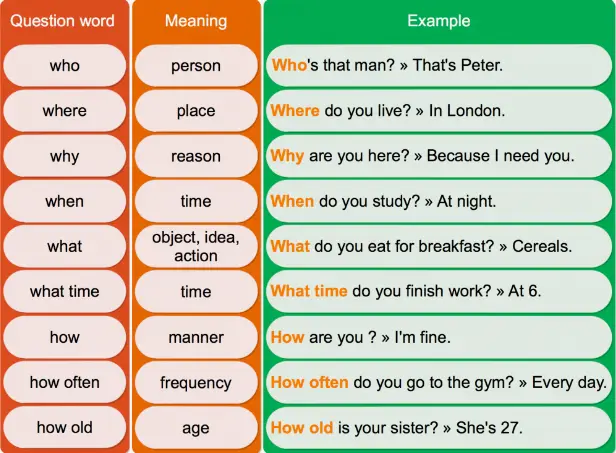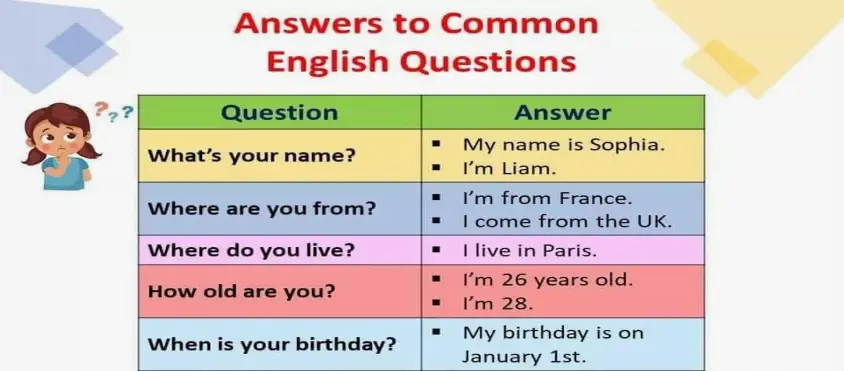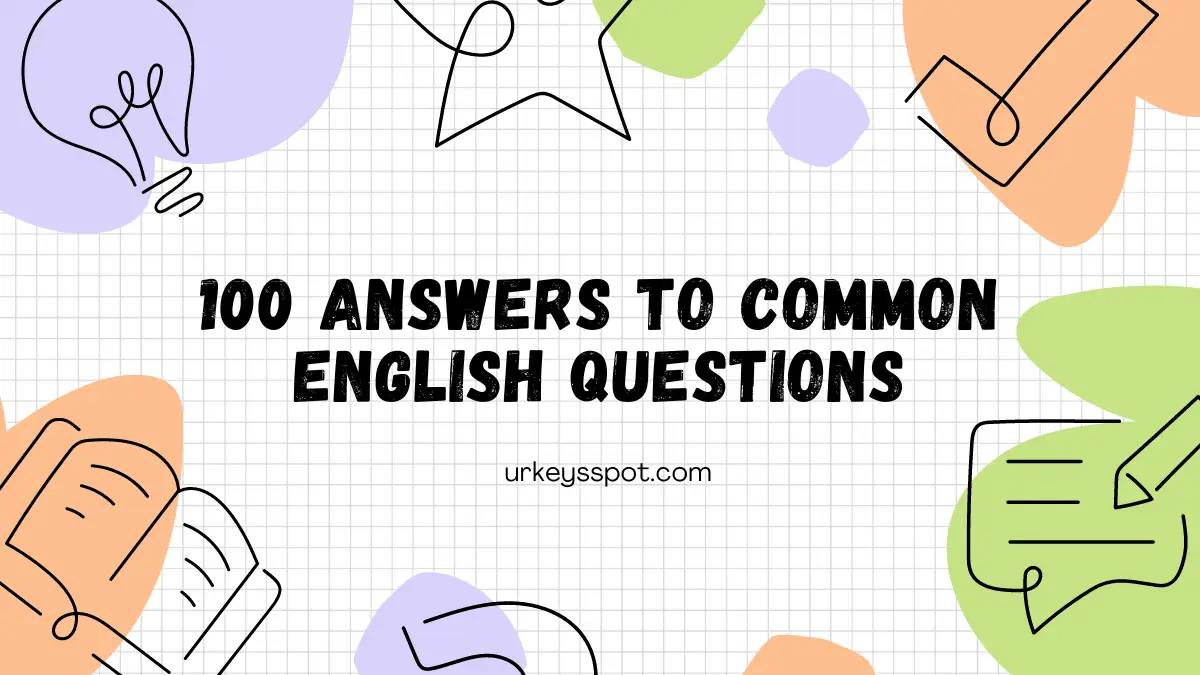Introduction to Common English Questions
Ah, English! A language as rich and as frustrating as a double-edged sword, right? Well, fear not, because we’re about to embark on a journey through the labyrinth of common English questions, a venture that promises to arm you with the verbal artillery you need to tackle day-to-day conversations with the ease of a seasoned linguist.
The English language wraps simple ideas in various expressions, from “How’s it going?” to “Need a hand?” Soon, you’ll explore this linguistic variety up close.
In this segment, we’ll peel back the layers of everyday English, offering you a peek into the heart of typical dialogues. From the grocery store to the boardroom, we’ve got you covered. So, buckle up, and let’s get this show on the road, delving into the dynamic world of greetings and social pleasantries.
Basic Social Interactions

Diving into the heart of English banter, let’s kick things off with the bread and butter of daily chit-chat: greetings and social pleasantries. These are the golden threads that weave the fabric of everyday conversation, setting the tone for a friendly and engaging dialogue.
Greetings and Social Pleasantries
Ever noticed how a simple “Howdy!” can light up someone’s face or how a warm “What’s cooking?” can break the ice? Greetings are the appetizers of our conversational feast, and they come in various flavors. Whether you’re in a bustling city café or a quiet country lane, knowing how to greet folks is your first step to a rewarding conversation.
- Starting Strong: Begin with a vibrant “Hello!” or a cheerful “Hi there!” These are your go-to starters, sure to kindle a spark in any chat.
- Follow-Up Finesse: After the initial hello, throw in a “How’s it going?” or “What’s up?” It’s like adding a pinch of salt to a dish – it just makes everything better.
- The Polite Ping: Sometimes, a simple “How are you?” is all you need. It shows you care, opening doors to deeper conversations.
Shopping and Services Interactions
Now, let’s waltz into the world of transactions and services. Whether you’re hunting for a bargain or seeking assistance, the right questions can make your journey smoother.
- The Helpful Inquiry: Stuck in a store? A polite “Can you help me find this?” can be your lifeline. It’s the question that invites solutions and shows you’re savvy and respectful.
- The Grateful Shopper: After finding what you need, don’t forget a heartfelt “Thank you!” Gratitude is the universal currency that enriches all interactions.
- The Curious Customer: Wondering about a product or service? “Could you tell me more about this?” opens up a trove of information, showing you’re interested and engaged.
To dive deeper into the art of greetings and expand your repertoire, discover more English learning resources here.
Daily Life Questions
Ah, the daily grind! It’s where the rubber meets the road in our conversational journey. From the moment the rooster crows to the time the moon takes its nightly bow, a plethora of questions pepper our day. Let’s navigate these with the grace of a ballet dancer and the precision of a clockmaker.
Questions About Daily Activities
Daily life is a tapestry woven with the threads of routine queries. Ever been asked, “What’s on your agenda today?” or found yourself inquiring, “Got any plans for the weekend?” These aren’t just questions; they’re bridges to human connection, offering a glimpse into the lives of those around us.
- The Morning Query: “What’s for breakfast?” isn’t just about food; it’s a warm-up for the day’s conversational marathon.
- The Midday Touchpoint: “How’s your day going?” This midday missile shows you care, keeping the conversational ball rolling.
- The Evening Reflection: “How was your day?” As the sun sets, this question wraps up the day’s narrative, inviting stories and shared experiences.
Personal Preferences and Opinions

Here’s where conversations get spicy! Personal preferences and opinions are the jazz improvisations of dialogue, unpredictable and full of flavor.
- The Preference Probe: “Do you prefer coffee or tea?” Simple yet profound, such queries reveal layers of personality.
- The Opinion Opener: “What do you think about the new park?” This is your conversational crowbar, prying open the doors to deeper discourse.
- The Hobby Inquiry: “What are your hobbies?” This question is a golden ticket to someone’s world, showcasing passions and pastimes.
Educational and Work-related Questions
In the grand theater of life, schools and workplaces are stages where the dialogue takes on a more serious tone. Yet, fear not! With the right questions, you can navigate these arenas with the finesse of a skilled diplomat.
Academic Environments
The hallowed halls of education are brimming with queries, from the curious to the critical. Whether you’re a student, educator, or just passing through, the ability to ask and answer succinctly is key.
- The Inquiry of Interest: “What’s your major?” A question as common as textbooks in a library, it’s the starting point for many an academic dialogue.
- The Clarification Quest: “Could you explain this concept?” This question is the key to unlocking the treasure trove of knowledge that your educator holds.
- The Future Forecast: “What are your plans after graduation?” Ah, the crystal ball question! It’s a peek into aspirations and dreams, steering conversations toward future horizons.
Professional Scenarios
The workplace is a melting pot of inquiries, each one a thread in the tapestry of corporate life. From the water cooler to the boardroom, knowing how to navigate these questions can make your professional journey smoother.
- The Task Tracker: “What’s on your to-do list today?” Not just a question, but a lifeline in the bustling sea of tasks, keeping you and your colleagues aligned.
- The Project Prober: “How’s the project going?” This question isn’t just about status updates; it’s a show of support and teamwork.
- The Feedback Seeker: “Can I get your input on this?” More than a question, it’s an invitation to collaborate, blending different perspectives into a masterpiece of productivity.
Understanding the cultural nuances behind English expressions can greatly enhance your communication skills. Learn more about the cultural context here.
Complex Interactions and Situations
Life’s not always a straight road; sometimes, it’s a winding path through the woods of complex interactions and delicate situations. But worry not! With the right questions and responses, you can navigate these woods like a seasoned ranger.
Handling Difficult Conversations
We’ve all been there – conversations that feel like walking on a tightrope. But with a pinch of tact and a dash of empathy, you can turn these moments into opportunities for growth and understanding.
- The Diplomatic Diverter: “Can we explore a different perspective on this?” This gem helps steer potentially rocky conversations into safer waters, encouraging a broader view.
- The Calm Clarifier: “Can you help me understand your point of view?” It’s not just a question; it’s a bridge, fostering mutual understanding and respect.
- The Peacekeeper’s Pivot: “What common ground can we find here?” This question is the olive branch of dialogue, seeking harmony in discord.
Social Events and Networking
Ah, the social butterfly’s arena! At casual meet-ups or formal networking events, the right questions can spotlight you.
- The Interest Igniter: “What brings you to this event?” It’s a simple opener that can lead to fascinating tales and shared interests.
- The Connection Catalyst: “How did you get started in your field?” This question isn’t just about careers; it’s a window into personal journeys and passions.
- The Relationship Builder: “Can we connect on [professional platform]?” In the digital age, this question is your digital handshake, extending your network far beyond the event.
To further refine your conversational skills and tackle a variety of situations with confidence, explore this comprehensive English guide.
Miscellaneous
Life, in all its glory, isn’t just about the routine or the complex; it’s also sprinkled with a smattering of random, light-hearted, or unexpected questions that spice up our daily dialogues.Let’s embrace this variety, adding a dash of unpredictability to our conversational repertoire.
Random and Fun Questions
These questions infuse a fun twist into our chats, breaking the monotony and sparking curiosity.
- The Curiosity Piquer: “If you could have dinner with any historical figure, who would it be?” This question isn’t just a conversation starter; it’s a portal to imagination and personal interests.
- The Hypothetical Handler: “What would you do if you won the lottery tomorrow?” It’s a playful probe into dreams and desires, revealing deeper layers of someone’s personality.
- The Preference Explorer: “Would you rather have the ability to fly or be invisible?” Such questions invite playful debate and reveal intriguing aspects of one’s character.
FAQs
What are the 10 questions in English with answers?
- What’s your name? – My name is [Your Name].
- How are you? – I’m doing well, thank you.
- Where are you from? – I’m from [Your Country/City].
- What do you do? – I work as a [Your Profession].
- How old are you? – I am [Your Age] years old.
- What’s your favorite color? – My favorite color is [Your Favorite Color].
- What time is it? – It’s [Current Time].
- What are you doing? – I am [Your Current Activity].
- How’s the weather today? – It’s [Describe the Weather].
- Can I help you? – Yes, please. / No, thank you.
What are basic questions in English?
Basic questions in English often revolve around personal information, time, location, preferences, and daily activities. Examples include ‘What’s your name?’, ‘Where are you from?’, and ‘What time is it?’. Others are ‘How are you?’ and ‘What do you do?’. These questions form the basis of basic English conversations.
What are good questions for English class?
Good questions for English class often encourage critical thinking, discussion, and deeper understanding of the material. Examples include:
- “What is the main theme of the text?”
- “How does the author develop the characters?”
- “What is the significance of the setting in the story?”
- “How does the plot evolve?”
- “What literary devices are used in the text?”
How can I ask questions in English?
To ask questions in English, use words like who, what, where, when, why, and how. Then, add the subject and verb. For instance:
- Who is your favorite author?
- What are you reading currently?
- Where did you go on your vacation?
- When is the meeting scheduled?
- Why are you learning English?
- How do you prefer to study?
Conclusion
And there we have it, a grand tour through the vibrant landscape of English conversation! We’ve explored a wide range of communication, from casual chats to professional talks and quirky musings.
Remember, at the heart of all these questions and answers lies the essence of connection and understanding. Each query you pose is a bridge you build toward someone else’s world, and every answer you offer is a glimpse into your own universe.
Embrace these interactions as opportunities to weave richer, more colorful tapestries of connection. With the tools and insights you’ve gathered here, you’re not just conversing; you’re crafting relationships, fostering understanding, and contributing to the grand mosaic of human interaction.
So, step forth with confidence, curiosity, and a touch of creativity. Let your conversations be as dynamic and diverse as the world around you. After all, every question asked and every answer given is a thread in the ever-evolving story of our interconnected lives. Happy chatting!

